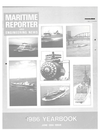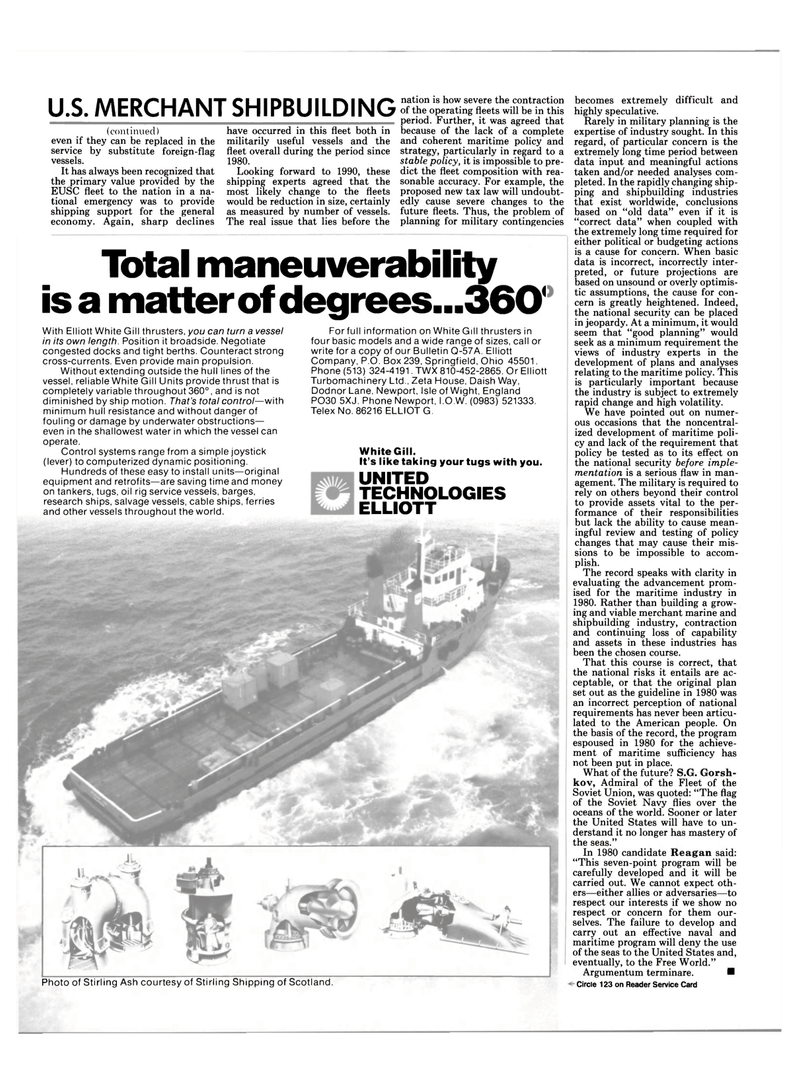
Page 42: of Maritime Reporter Magazine (June 1986)
Read this page in Pdf, Flash or Html5 edition of June 1986 Maritime Reporter Magazine
becomes extremely difficult and highly speculative.
Rarely in military planning is the expertise of industry sought. In this regard, of particular concern is the extremely long time period between data input and meaningful actions taken and/or needed analyses com- pleted. In the rapidly changing ship- ping and shipbuilding industries that exist worldwide, conclusions based on "old data" even if it is "correct data" when coupled with the extremely long time required for either political or budgeting actions is a cause for concern. When basic data is incorrect, incorrectly inter- preted, or future projections are based on unsound or overly optimis- tic assumptions, the cause for con- cern is greatly heightened. Indeed, the national security can be placed in jeopardy. At a minimum, it would seem that "good planning" would seek as a minimum requirement the views of industry experts in the development of plans and analyses relating to the maritime policy. This is particularly important because the industry is subject to extremely rapid change and high volatility.
We have pointed out on numer- ous occasions that the noncentral- ized development of maritime poli- cy and lack of the requirement that policy be tested as to its effect on the national security before imple- mentation is a serious flaw in man- agement. The military is required to rely on others beyond their control to provide assets vital to the per- formance of their responsibilities but lack the ability to cause mean- ingful review and testing of policy changes that may cause their mis- sions to be impossible to accom- plish.
The record speaks with clarity in evaluating the advancement prom- ised for the maritime industry in 1980. Rather than building a grow- ing and viable merchant marine and shipbuilding industry, contraction and continuing loss of capability and assets in these industries has been the chosen course.
That this course is correct, that the national risks it entails are ac- ceptable, or that the original plan set out as the guideline in 1980 was an incorrect perception of national requirements has never been articu- lated to the American people. On the basis of the record, the program espoused in 1980 for the achieve- ment of maritime sufficiency has not been put in place.
What of the future? S.G. Gorsh- kov, Admiral of the Fleet of the
Soviet Union, was quoted: "The flag of the Soviet Navy flies over the oceans of the world. Sooner or later the United States will have to un- derstand it no longer has mastery of the seas."
In 1980 candidate Reagan said: "This seven-point program will be carefully developed and it will be carried out. We cannot expect oth- ers—either allies or adversaries—to respect our interests if we show no respect or concern for them our- selves. The failure to develop and carry out an effective naval and maritime program will deny the use of the seas to the United States and, eventually, to the Free World."
Argumentum terminare. •
Circle 123 on Reader Service Card
U.S. MERCHANT SHIPBUILDING (continued) even if they can be replaced in the service by substitute foreign-flag vessels.
It has always been recognized that the primary value provided by the
EUSC fleet to the nation in a na- tional emergency was to provide shipping support for the general economy. Again, sharp declines have occurred in this fleet both in militarily useful vessels and the fleet overall during the period since 1980.
Looking forward to 1990, these shipping experts agreed that the most likely change to the fleets would be reduction in size, certainly as measured by number of vessels.
The real issue that lies before the nation is how severe the contraction of the operating fleets will be in this period. Further, it was agreed that because of the lack of a complete and coherent maritime policy and strategy, particularly in regard to a stable policy, it is impossible to pre- dict the fleet composition with rea- sonable accuracy. For example, the proposed new tax law will undoubt- edly cause severe changes to the future fleets. Thus, the problem of planning for military contingencies
Total maneuverability is a matter of degrees...360*
With Elliott White Gill thrusters, you can turn a vessel
In Its own length. Position it broadside. Negotiate congested docks and tight berths. Counteract strong cross-currents. Even provide main propulsion.
Without extending outside the hull lines of the vessel, reliable White Gill Units provide thrust that is completely variable throughout 360°, and is not diminished by ship motion. That's total control—with minimum hull resistance and without danger of fouling or damage by underwater obstructions— even in the shallowest water in which the vessel can operate.
Control systems range from a simple joystick (lever) to computerized dynamic positioning.
Hundreds of these easy to install units—original equipment and retrofits—are saving time and money on tankers, tugs, oil rig service vessels, barges, research ships, salvage vessels, cable ships, ferries and other vessels throughout the world.
For full information on White Gill thrusters in four basic models and a wide range of sizes, call or write for a copy of our Bulletin Q-57A. Elliott
Company, P.O. Box 239, Springfield, Ohio 45501.
Phone (513) 324-4191. TWX 810-452-2865. Or Elliott
Turbomachinery Ltd., Zeta House, Daish Way,
DodnorLane, Newport, Isle of Wight, England
P030 5XJ. Phone Newport, I.O.W. (0983) 521333.
Telex No. 86216 ELLIOT G.
White Gill.
It's like taking your tugs with you.
UNITED
TECHNOLOGIES ELLIOTT
Photo of Stirling Ash courtesy of Stirling Shipping of Scotland.

 41
41

 43
43
